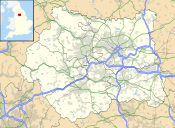Ferrybridge Henge facts for kids
Ferrybridge Henge is a very old circular monument. It was built during the Neolithic period, also known as the New Stone Age. This important site is located near Ferrybridge in West Yorkshire, England. It's close to the A1 and M62 roads, and the Ferrybridge power station.
Ferrybridge Henge is the most southern henge in Yorkshire. It is also the only one found in West Yorkshire. This site is very important to the country's history. It is protected as a Scheduled Ancient Monument, which means it cannot be changed without permission. However, farming activities like ploughing still threaten it.
The History of Ferrybridge Henge
People were active at this location even before the henge was built. Around 3500 to 3000 BC, there were other circular monuments here. Ferrybridge Henge itself was built between 3000 and 2500 BC.
Later, during the early Bronze Age (around 2000 to 1500 BC), people used the site for burials. They buried their dead in mounds called barrows. These burials often included special items, like ceramic pots and flint tools.
The area might have been left empty for a while. Then, from about 500 BC, Iron Age farmers lived there. The henge itself was not farmed. It might have been kept as a special place or shrine for these Iron Age people. It may have also been used during the Romano-British period. Archaeologists found an Iron Age sword scabbard and a Roman coin in the henge's inner ditch.
Even during the Saxon period, people continued to bury their dead near the henge. This happened even though there was a Christian cemetery nearby. This suggests that older beliefs were still strong in the area. In the medieval period, Ferrybridge Henge and its surroundings were used as farmland.
Archaeologists from West Yorkshire Archaeological Services dug up the site in 1991. This is called an excavation. In 2007, they found what might be an extension of the henge near Pontefract. This discovery included old field systems and drainage ditches. These are thought to be from the Iron Age or Romano-British times. This new area was found during a survey for a new housing development.
What Ferrybridge Henge Looks Like
Ferrybridge Henge is a circular site. It measures about 180 meters (590 feet) across. The henge has two ditches and a bank around it.
The inner ditch is 10 meters (33 feet) wide and 2.5 meters (8 feet) deep. There is a flat area, called a berm, between this ditch and the bank. This berm is 15 meters (49 feet) wide.
The bank itself is also 15 meters (49 feet) wide and made of limestone. Another berm, also 15 meters (49 feet) wide, separates the bank from the outer ditch. The outer ditch is 12 meters (39 feet) wide and 1.5 meters (5 feet) deep. This design is common for other henges found in Britain.
The site has two main entrances. One is in the northeast, and the other is in the southwest.
Images for kids




